
 |
|
||||||||||||||||||||||||
|
Alaska's Heritage
CHAPTER 4-17: FARMING, HERDING, AND LUMBERING
Agriculture includes farming, herding, and lumbering Agriculture is the business of cultivating the soil, producing crops, and raising livestock. In Alaska, raising livestock has included fur farming and reindeer herding. Because it uses products grown in soil, trees, lumbering is also discussed in this section. Lumbering includes the cutting of trees and the processing of lumber into boards and pulp. Agriculture in Alaska has always fallen far below mining, fishing, trapping, and recently, tourism, in its significance to Alaska's economy. Yet, there has been great interest in Alaska's agricultural potential during the American era of Alaska's history. Traders, missionaries, prospectors, and miners attempt to farm Some farming that began while the Russians administered Alaska continued on Kodiak Island, on the Kenai Peninsula, and near Sitka after 1867. Americans tried to raise crops and livestock in other areas of Alaska, mostly around trading posts. The farms were small and served only local markets. The costs of bringing food from west coast ports to Alaska, however, was high. Missionaries and prospectors who began to arrive in Alaska in the 1870s attempted farming. The missionaries hoped to make their outposts self-sufficient. By 1888, the Roman Catholic missionaries at Holy Cross on the lower Yukon River produced most of the food they needed. This included eggs, vegetables, milk, and meat. They raised more than 300 bushels of potatoes annually and sold the surplus to prospectors, miners, trappers, and traders along the river. 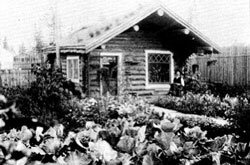 Many early residents in Interior Alaska planted gardens around their cabins. Collection Name: Alaska Historical Library, Albert J. Johnson Collection. Identifier: PCA 113-35 Most potential farmers discovered that costs to bring farm machinery and fertilizer to Alaska were prohibitively expensive. Local labor costs were also high. Often agricultural products imported from Washington or California could be sold for less. Early Alaskans considered fresh dairy products, fruits, and vegetables luxuries. Federal officials slowly encourage agriculture Federal officials hoped that local efforts to raise crops and livestock would succeed, but they did little to encourage people to farm. Few early farmers owned the land they worked. The first Alaska land laws only provided for town, trade, and manufacturing sites. In 1897, the U.S. Department of Agriculture sent Walter H. Evans and Benton Killen to investigate farming possibilities in Southeast and Southcentral Alaska. Sheldon Jackson surveyed the farming potential along the Yukon River. The next year, Congress passed a homestead act for Alaska. The law required that land be surveyed before it could be homesteaded, and this greatly diminished the law's effectiveness. Five years later the act was amended to allow a homesteader to get title to 320 acres of land without a survey. Congress enacted separate legislation that gave similar homesteading rights to Alaska Natives. Along with passing the homestead act in 1898, Congress provided money to establish several agricultural experiment stations in Alaska. 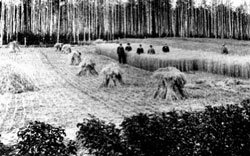 The Fairbanks agricultural experiment station farm. Collection Name: Alaska Historical Library, Albert J. Johnson Collection. Identifier: PCA 113-33 Georgeson opened agricultural experiment stations at Sitka and Kenai his first year in Alaska. Others followed, Georgeson also sent vegetable seeds, plants, and instructions to trading post operators and other interested individuals. Georgeson estimated that 100,000 acres in the Tanana River valley of Interior Alaska could be developed. One successful farmer, Paul Rickert, cultivated 100 acres near Fairbanks. Rickert sold milk, butter, eggs, and pork in Fairbanks markets, but he specialized in produce. In 1908, Rickert raised two and a half tons of greenhouse tomatoes, 15,000 heads of cabbage, 15,000 stalks of celery, 10 tons of potatoes, and large quantities of turnips, beets, carrots, parsnips, peas, and beans. Many roadhouse operators maintained hay fields to provide food for horses. The roadhouse operators also raised vegetables for the meals they served to travelers. Some shipped in cattle each spring, fattened them during the summer on grass and wild hay, then slaughtered the animals in the fall. Cattle and sheep adapt to Kodiak and Aleutian islands Attempts to raise cattle on Kodiak and Aleutian islands began in 1867. The Alaska Commercial Company had a dairy herd at Kodiak and grazed cattle on nearby Long Island. Sheep were also introduced in the Aleutian Islands. Ranches operated at Chernofski and Nikolski on Umnak Island by the late 1800s. Although the meat could not be economically marketed, the wool could be profitably sold. By 1927, there were 7,475 sheep, 819 beef cattle, and 79 dairy cows on the Kodiak and Aleutian islands. Fox farms flourish during the 1920s Another type of farming, raising animals for their fur, flourished in Alaska for a while. The Russians had placed silver and blue fox on several Aleutian Islands in the early 1800s. The Americans who followed expanded fox farming to islands near Kodak by the 1880s. When fur prices soared after world war I, many individuals started fox farms on islands in Southeast and Southcentral Alaska as well. Fox farms did not require much capital. In Southeast Alaska an island could be leased from the U.S. Forest Service for as little as $25 a year. One or two pairs of fox were enough to stock an island. Nearby canneries provided cheap feed. The fox also ate wild birds and eggs. In addition to silver and blue fox, the farmers experimented with raising mink, marten, beaver, and muskrat. The depression of the 1930s destroyed the fox farming industry. Prices of furs dropped dramatically. By the time the prices of furs rose after world War II, few farms survived. Commercial farming in Alaska develops slowly Homesteaders began to move into the Matanuska Valley in the early 1900s. By 1917, gold mining in the Willow Creek district, development of the Chickaloon coal field, and construction of the Alaska Railroad had led to 400 homestead entries. Only 175 of the entries were later patented. Matanuska Valley farmers formed an association in 1917 to build a crop storage building and to deal with livestock feed supply. A similar association, the Tanana Valley Agricultural Association, Inc., formed in 1919 in the Tanana Valley. It began with 157 stockholders. The association provided storage for potatoes, vegetables, hay, and grain. In 1921, they added a flour mill. Farmers hoped these organizations would lower their costs and make their products competitive in price with similar products freighted from the west coast to Alaska. 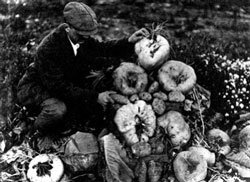 The large size of some vegetables grown in the Matanuska Valley became area farmers' tradmark. Collection Name: Alaska Historical Library, Alaska Railroad Collection. Identifier: PCA 108-77 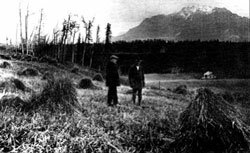 Homesteaders started to move into the Matanuska Valley in the early 1900's. Here, two men are looking over the hay crop in 1919. Collection Name: Alaska Historical Library, Alaska Railroad Collection. Identifier: PCA 108-89 Despite these encouraging developments, few commercial farming operations in Alaska succeeded. Farming in Alaska was difficult. Handicaps included poor soil, a short growing season, permafrost, limited investment capital, high labor costs, expensive machinery and supplies, and haphazard marketing. In 1923, only 90 farms, each averaging around 15 acres in size, operated in the Anchorage, Matanuska, and Fairbanks areas. The farmers primarily produced grain and hay for horses, milk, eggs, and vegetables. In the late 1920s, the Alaska Railroad began a campaign to encourage farming along the railroad route. It opened an office in Chicago and published a pamphlet, "Alaska, Our Newest Homeland," that was distributed throughout the Midwest. Steamship lines and railroads offered special rates for homesteaders. The campaign lured about 100 settlers. The economic depression of the 1930s hurt agricultural development in Alaska. The Department of Agriculture at the Agricultural College and School of Mines was closed. Work at agricultural experiment stations was reduced. The federal government establishes an agricultural colony in Alaska Many Midwestern farmers lost their farms during the depression. Federal officials thought Alaska might be a place where some such farmers could resettle. The Federal Emergency Relief Administration began planning an agricultural colony in the Matanuska Valley. The project would help develop the area. The Matanuska Valley plan differed from the federal government's resettlement efforts in other states. In Alaska, the project attempted to create a new agricultural community. Other programs relocated families to existing communities. The proposal had many critics. Some pointed out that for the same amount of money that it would take to bring a settler to Alaska, the government could buy a working farm in Iowa. Despite the critics, 202 families headed north in 1934. The Alaska Rural Rehabilitation Corporation (ARRC7 purchased land and offered long-term, low-interest loans to the colonists. The land was initially divided into 40-acre tracts. The corporation hired colonists to work on roads and to build schools, homes, stores, offices, and warehouses. It provided household goods and farm equipment and offered health and recreation services. After the farms began producing, the corporation managed crop production, processing, and distribution. Construction projects progressed well, but land clearing progressed slowly. A few gardens were producing by 1937 and a dairy opened. By September 1938, only about 2,000 acres of land had been cleared. Over a quarter of the 40-acre tracts had such poor soil and drainage that they had to be doubled in size. By July 1936, 67 of the original 202 families had left the colony. At the end of the second year, many families were $10,000 in debt. The colony experiment was as costly as critics had predicted. The costs totaled $5.4 million, five times higher than estimated. Some called the program an expensive success. Others saw it as an expensive failure. One report noted that land put into crop production by the new settlers could have been equaled in the corner of one county of a midwestern state. Regardless of the success or failure of the colony, by 1940 the Matanuska Valley had become a stable agricultural community. There were 118 tracts of land under cultivation. The World War II military activity and the huge increase in the population of the Anchorage area provided markets for Matanuska Valley farm products. In 1939, the federal government transfered the cooperative marketing and purchasing association, today known as Matanuska Maid, to farmer members. During the years 1940 to 1960, farmers in the Matanuska Valley focused on milk and potato production. Post-war growth stimulates Alaska's agriculture By 1949, there were 525 farms in Alaska and 217 of them were commercial operations. Most of these farms were in the Matanuska and Tanana River valleys. The same year, the federal government created the Alaska Research Station at Palmer. The station sought to increase farm production. Within ten years, farm production in Alaska had doubled. Milk accounted for 49 per cent and potatoes accounted for 25 per cent of annual farm production. Beef cattle and sheep herds on Kodiak and the Aleutian islands increased. In the late 1960s, slaughter houses were built on Kodiak and Umnak islands. In 1969, the state established a meat inspection program. Still, farming in Alaska was not a great success. In 1964, the U.S. Department of Agriculture spent $7.5 million in Alaska, approximately $19,000 per farm. This expenditure was two million dollars more than the value of Alaska's agricultural production that year. In 1963, fresh milk transported by truck from Seattle retailed in Fairbanks for a dollar per half gallon. Of this cost, 40 cents covered transportation and handling costs from Seattle. The same year, the military began to enforce a contract requirement calling for a 48-hour limit between pasteurization and delivery. This requirement, in effect, stopped truck shipment of fresh milk from Seattle to Fairbanks. For a short period, dairies in the Matanuska and Tanana River valleys profited from the new regulation. Alaskan agriculture can not compete As air and refrigeration freight costs declined, milk and other dairy products from the Pacific Northwest could be sold in Alaska for less than locally-produced products. In 1949, for example, eggs cost $1.45 a dozen produced in the Matanuska Valley, $1.30 a dozen shipped in by air, and 85 cents a dozen boated to Anchorage. Another new threat to agriculture in the Matanuska Valley was the demand for residential land as Anchorage became Alaska's largest city. Many people who worked in Anchorage built homes in the Matanuska Valley. Farm land became more expensive and taxes increased. Many farmers sold their land to be used for housing tracts. The State of Alaska supports agricultural efforts In 1976, Governor Jay Hammond proposed that the State of Alaska support a large-scale grain farming project in the Delta-Clearwater area of the Tanana River Valley. Because barley required a short growing season and could mature in cool temperatures, promoters thought that it could be commercially grown in Alaska. By the beginning of the 1980s, the State of Alaska had sold or leased about 84,000 acres of land for grain farming. The state sold land at minimum cost, but restricted its use to agricultural purposes. The state agreed to arrange for storage facilities, transportation, and marketing of crops grown on these farms. Still, the venture was risky. Farmers faced uncleared land, bison herds traveling through the area, range fires, rough weather, and lack of a market. More recently, the State of Alaska became involved in a second agricultural venture at Point MacKenzie in Southcentral Alaska. A minimum of 19 dairy farms were expected to be established. With the existing dairy farms in the Matanuska Valley, the Point MacKenzie farms could supply over 50 per cent of the fresh milk for the Anchorage area. The state assisted by clearing large tracts of land and offered tracts of land for sale at low interest rates. In 1984, there were 650 farms operating throughout Alaska. The first reindeer are brought to Alaska The tundra of western and northern Alaska was not suited for agriculture, but some like Revenue Marine Service Captain Michael A. Healy and zoologist Charles H. Townsend, who sailed with Healy on the Corwin in the Bering Sea during 1885, thought reindeer could be grazed there. The two men observed that Siberian Natives had domesticated reindeer, which provided them with food and hides. They suggested to Sheldon Jackson, then General Agent for Education for Alaska, that reindeer could be introduced in Alaska. Reindeer could provide food for those who depended on the reduced populations of seals, walrus, and whales. Jackson obtained $2,146 from private funds to buy Siberian reindeer and obtained the use of the revenue cutter Bear to transport reindeer from Siberia to Alaska. in 1891, the first 16 reindeer purchased from Siberian Eskimos were taken to Unalaska Island. These animals died. Undeterred, Jackson took 171 reindeer to the Seward Peninsula the next year. Jackson chose a site on the north shore of Port Clarence near Teller for a reindeer station. Between 1891 and 1902, a total of 1,296 reindeer were imported to Alaska from Siberia. Bringing reindeer from Siberia to Alaska stopped in 1902 after the tsar of Russia prohibited further exportation. By that time, it was not necessary to bring more reindeer, because the animals doubled their numbers every three years.Missionaries become involved in reindeer herding Missionaries William and Ellen Lopp transferred from their school at Cape Prince of Wales to spend 1893-1894 managing the reindeer station. When they returned to Cape Prince of Wales, they brought 118 reindeer with them to start a new herd. 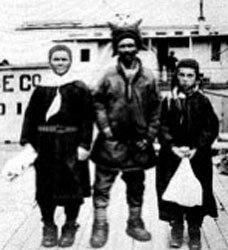 Laplanders from northern Euroope were brought to Alaska to teach Alaska Natives to raise and herd reindeer. Collection Name: Alaska Historical Library, B.B. Dobbs Collection. Identifier: PCA 12-95 The first reindeer herders brought to Alaska were Siberian Eskimos. Although they had long-established trade relationships with the Alaskan Eskimos, the two groups were ancient enemies. In 1894, Laplanders from northern Europe replaced the Siberian herders. The Lapps were good herders and got along better with the Alaskans.  Reindeer were used to haul freight and transport people around Northwest Alaska. This eskimo man is hauling reindeer meat to markets at Nome. Collection Name: Alaska Historical Library, B.B. Dobbs Collection. Identifier: PCA 12-179 For the most part, however, the apprentice system did not work very well. By 1903, only 68 Eskimos actually owned reindeer. Missions and Lapp herders owned most of the reindeer. The reindeer industry develops Local markets for reindeer meat and hides had been created by the people lured to Alaska by the gold rush. Miners bought reindeer for food. Reindeer were often used to haul freight on the Seward Peninsula. In 1907, Lopp, who had helped establish the reindeer industry, succeeded Jackson. as General Agent for Education in Alaska. Lopp increased the number of government reindeer stations so there were more apprenticeship positions through which Natives could become reindeer owners. By 1915, over 1,000 Natives owned reindeer herds. Walter C. Shields, head of the government reindeer station at Nome, tried to help owners learn better ways to herd and care for their reindeer. Shields arranged reindeer fairs where herd owners could exchange information. Herders gathered in late winter for a week of contests involving reindeer. They also listened to lectures on animal husbandry. Some fairs led to cooperation among owners to round up and market reindeer. As gold miners left, the Alaska market for reindeer products declined. Reindeer overgrazed parts of Western Alaska. Another blow to the reindeer industry was the death of Shields in the 1918-1919 influenza epidemic. After his death, few reindeer fairs were held. A number of herders also died in the epidemic. Many untended deer joined herds of wild caribou or fell victim to wolves. The lumen brothers enter the reindeer industry Carl Lumen and his father came to Nome in 1900. They stayed after the gold rush, and the rest of the family moved north. When laws restricting ownership of reindeer to Eskimos and missionaries were rescinded in 1914, the family organized Lumen and Company and bought a herd of 1,200 reindeer. Within six years, the Lumens had increased their herd to 8,600 animals. Beginning the first commercial shipments of reindeer meat in 1915, the next year Lumen and Company shipped a little more than 10,000 pounds of reindeer meat to markets outside Alaska. The Lumens worked hard to market reindeer products. They had meat made into sausage. They hired Eskimo women to sew reindeer clothing. Midwest beef growers campaigned to keep reindeer meat out of U.S. markets. Some states considered reindeer to be game animals that could not be sold commercially without a special permit. Nevertheless, by 1920 the Lumens annually sold 250,000 pounds of reindeer meat to U.S. markets. The reindeer industry falters and revives The world-wide economic depression of the 1930s destroyed the markets for reindeer products. When Congress passed a law in 1937 that prevented non-Natives from owning reindeer, it appeared that the industry in Northwest Alaska would die. The federal government purchased the reindeer owned by non-Natives and sold them to Native herders. A few individuals continued to maintain herds and sell meat and hides to local markets. In 1964, the owners formed the Northwest Reindeer Association to encourage cooperation in round-ups. After the Alaska Native Claims Settlement Act passed in 1971, NANA Regional Corporation assumed increased responsibilities for the reindeer industry in its region. Koreans began buying reindeer horns to sell in Asia as a health tonic. By the 1980s, the value of the horns surpassed the value of the reindeer meat and hides. In 1984, there were around 25,000 to 35,000 reindeer in 12 to 15 herds in Northwest Alaska. Interest rises in developing Alaska's forests During the late 1800s, lumber companies looked at Southeast Alaska's extensive Sitka spruce and western hemlock forests hoping to develop a significant export-oriented industry. Although the white spruce, birch, and cottonwood forests found in Southcentral and Interior Alaska were extensive, companies considered their commercial market to be local. The development of fishing and mining industries and the growth of new settlements after 1867 increased use of Alaska's forests. Small sawmills opened in the 1880s in Southeast Alaska communities such as Juneau, Ketchikan, Metlakatla, Wrangell, and Sitka. One of these sawmills was at Gravina near Ketchikan. Two Tsimshian men, Mark Hamilton and Peter Simpson, organized a company in 1892 and built the sawmill at Gravina. They hired 15 people to work cutting trees and 25 people to work at the mill. in 1900, the sawmill produced 1,206,000 board feet of rough lumber, matched flooring, shiplap, boat lumber, and cases for salmon canneries at Loring and Quadra. A fire in 1901 destroyed the sawmill, however, and it was not rebuilt. As the fishing industry expanded, logs were used for wharf pilings, fish traps, and cannery buildings. Lumber was used at mines to construct shafts and sluice boxes. By 1901, the annual production of timber in Southeast Alaska had reached 11 million board feet. In Interior Alaska, steamboats on the Yukon River used wood from the adjacent forests. In 1900, more than 50 steamboats operated on the Yukon River. Steamboats of the Northern Commercial Company used 48,438 cords of wood between 1897 and 1902. The boats consumed one to five cords of wood an hour. A round trip between St. Michael and Dawson cost approximately $15,000 in wood. Larger companies maintained wood yards and hired people to cut and stack wood. More commonly, individuals sold wood to companies for around $10 a cord. Later, millions of board feet of timber would be cut for railroad ties and pilings in Southcentral and Interior Alaska. Wood also heated many cabins and homes. The Fort Egbert army post at Eagle used over 1,000 cords of wood annually. The federal government does not promote a timber industry The federal government passed no provisions for lumbering in Alaska. In 1886, two ships loaded with nearly one million board feet of Alaska lumber were seized at San Francisco for carrying illegally cut and exported timber. The same year, a cannery at Klawock was forbidden to ship its fish products in barrels and boxes manufactured from Alaskan lumber. In 1890, the federal government threatened to take legal action against the 11 operating sawmills in Alaska. This situation persisted until 1898. That year, Congress passed a law authorizing the Secretary of the Interior to sell Alaskan lumber to meet the needs of the District of Alaska. The law also allowed an individual to take $100 worth of timber from public lands each year. This timber could be taken free of charge if used for local building and mining purposes. Provision was also made for commercial cutting of timber and payment for such timber at appraised cost. However, no appraisals existed and there was no one to do the assessment. Commercial lumbering continued without legal sanction. Tongass National Forest is created In 1891, Congress passed the Forest Reserve Act. This act permitted the president to withdraw forest lands and preserve them. It was hoped that forest reserves would prevent the sort of unregulated logging that had stripped large areas of the northern United States. President Benjamin Harrison created the first Alaskan reserve, the Afognak Island Forest and Fish Culture Reserve, in 1892. The conservation movement during the first decade of the 1900s led to the establishment of additional forest reserves in Alaska. The Alexander Archipelago Forest Reserve was created in 1902. This reserve included Chichagof, Kuiu, Kupreanof, Zarembo, and Prince of Wales islands in Southeast Alaska. It encompassed 4,506,240 acres. The 2,262,624-acre Tongass National Forest was reserved in 1907. It included land between Behm Canal and Portland Canal. The two reserves were combined the next year. In February 1909, outgoing President Theodore Roosevelt added 8,724,000 acres to the national forest. A total of 15,480,986 acres-most of Southeast Alaska south of Mount St. Elias-became a national forest. William A. Langille, the first forest superintendent in Southeast Alaska, set to work in 1903 mapping boundaries, enforcing hunting laws, examining mining claims, and arranging timber sales. Forest land in Southcentral Alaska is reserved In 1904, Langille surveyed other parts of Alaska to see if additional forest reserves were needed. Following three months in Southcentral Alaska, he recommended that a forest reserve be established there. Although the timber in most of Southcentral Alaska would not yield top quality lumber, it could be used for building. Protection was necessary, Langille argued, because of the extremely slow growth rate of trees in the area. A reserve also provided fire control. Chugach National Forest was created on July 23, 1907. The reserve's five million acres included most of the land between the Copper River, the Kenai Peninsula, and the Chugach Mountains. In 1908, the Chugach and Afognak reserves were combined, and in 1909, the boundaries were expanded. Between 1915 and 1919, untimbered lands along the west side of the Kenai Peninsula and the north shore of Turnagain Arm were eliminated from the reserve. In the end, the reserve was reduced from 11,263,140 acres to 5,232,250 acres. Langille also recommended a forest reserve in the Fortymile River area. This reserve was not established. Commercial lumbering begins Initially, handloggers worked in Tongass National Forest. Working without power tools, they cut trees growing close to the shoreline and skidded them into the water. In the water, the trees were fastened into rafts, towed to mills, and sold. Steam logging in Alaska's forests started about 1900. Southeast Alaska timber proved best suited for the manufacture of pulp--a crushed mass of wood and fibers used to make paper, rayon, and other synthetics. Pulp mills required large amounts of water which was plentiful in Southeast Alaska. The mills were expensive to build, however. In addition, shipping costs were high, and Douglas fir from Puget Sound was more popular than Sitka spruce with mill owners. Still, a lumbering industry in Southeast Alaska grew steadily. By 1910, sawmills operated in 25 locations along the coasts of Southeast and Southcentral Alaska. There were mills at Seward, Valdez, Cordova, Katalla, Douglas, Juneau, Sitka, Petersburg, Wrangell, and Ketchikan. Most of these were small. More than a third of the lumber processed was used for salmon cases by Alaska canneries. World wars impact Alaska's lumbering industry Increased aircraft construction during World War I had a slight effect on Alaska's lumbering industry. Sitka spruce from Ketchikan and Craig was cut for fighter planes. To be suitable for aircraft, wood grains had to be straight. Half of the first barge shipment of wood from an Alaskan mill was rejected. During World War II, the Alaska Spruce Log Program started. One of the program's goals was to cut 100 million board feet of Sitka spruce annually at Edna Bay, west of Prince of Wales Island. Nine logging camps operated, and over 200 people worked in the area. Cut logs were formed into Davis rafts, ocean-going rafts of logs 280 feet long, 60 feet wide, and 30 feet deep. Tugboats towed the rafts to mills in Puget Sound. By 1944, however, metal had replaced wood in fighter planes. The Alaska Spruce Log Program ended. During the program's life, a total of 38.5 million board feet of high grade Sitka spruce went to the states for processing. Pulp mills are built in Southeast Alaska In the 1950s, the U.S. Forest Service signed several long-term contracts for cutting timber on Alaska national forest lands. The annual timber harvest doubled and then quadrupled. Pulp mills, so long proposed, were built near Ketchikan and Sitka. The Ketchikan Pulp Company's $55 million mill at Ward Cove was the largest single industrial investment made in the territory up to that time. The first load of pulp was shipped from Ward Cove to Argentina under the brand name Tongacell in 1954. The Japanese became interested in Alaska's lumber. In sore companies, Japanese became investment partners. The Japanese wanted to import round logs and not processed lumber. A primary manufacturing regulation passed in 1926 prevented this. The regulation required that all Alaska timber from national forests that was exported had to be processed in the United States. The intent was to provide more jobs for Americans and to aid pulp and lumber mills. The result was that Alaska lumber products were often too high-priced to be competitive with others. Although troubled, the timber industry is significant to Alaska Despite the problems, lumbering was a significant Southeast Alaskan industry. The annual timber harvest increased from 50 million board feet in 1949 to 350 million board feet in 1960. In 1973, over 700 million board feet of timber were cut in Southeast Alaska. The industry employed over 2,500 people in 1960, and by 1976, over 5,200 people during peak months. In Southeast Alaska, 69 logging companies operated in 1971. The largest, Ketchikan Pulp Company, employed over 100 people at Thorne Bay on Prince of Wales Island. In other areas of Alaska, development of timber resources was slight. Small sawmills in Southcentral and Interior Alaska processed house logs, rough lumber, and poles. In 1977, five mills produced nine million board feet of lumber for the local market. This only accounted for 12 per cent of the lumber used in the railbelt area. During the 1960s, 1970s, and 1980s, new laws relating to forest uses were passed. Protecting the environment influenced forest management. The first significant piece of legislation was the Multiple Use-Sustained Yield Act of 1960. Wilderness and wild and scenic river areas were to be identified. The effects of clear-cutting and water pollution became concerns. The U.S. Forest Service changed its goal from developing a timber industry in Alaska to managing forest lands and achieving a long-term sustained yield from lumbering. The State of Alaska's Division of Forestry adopted a similar goal.
|
|||||||||||||||||
|